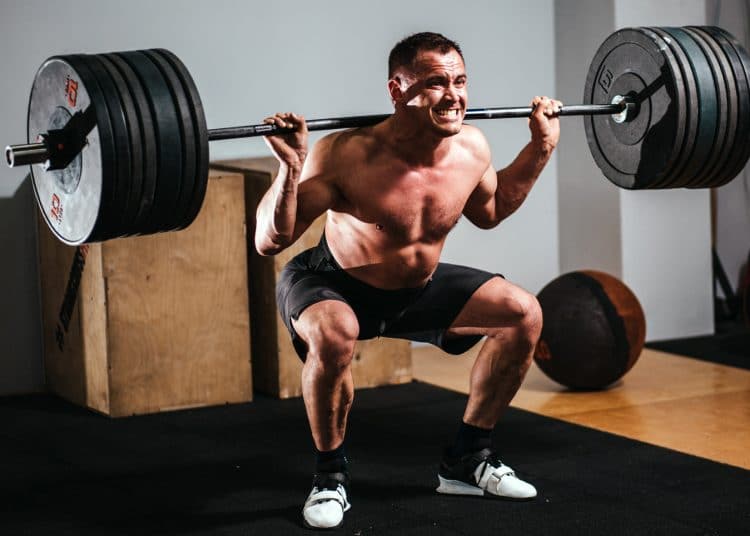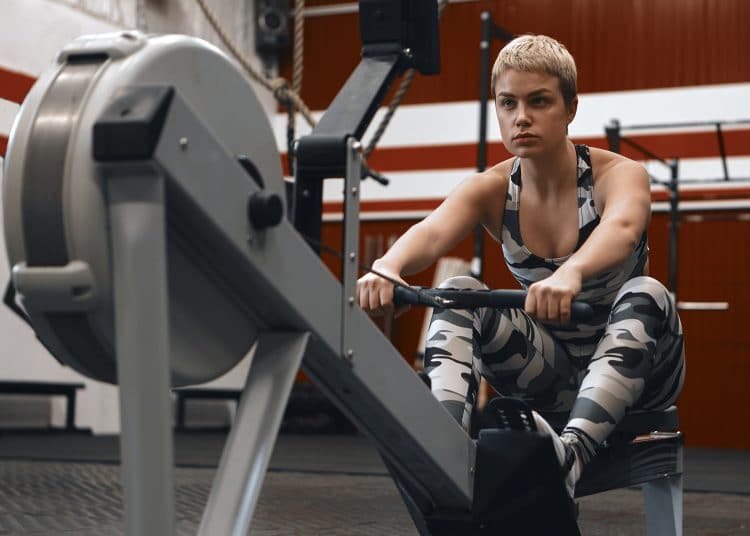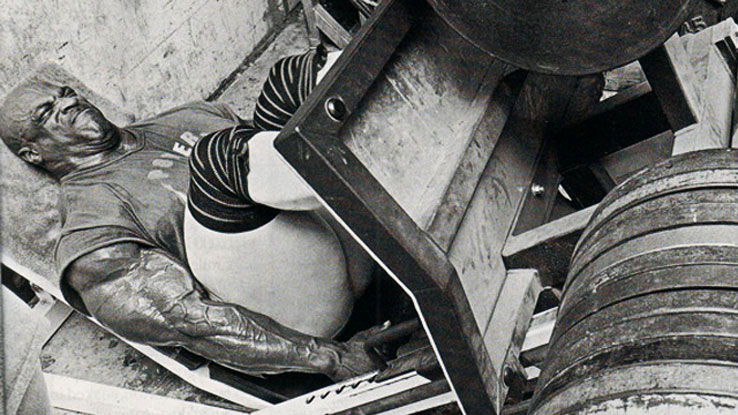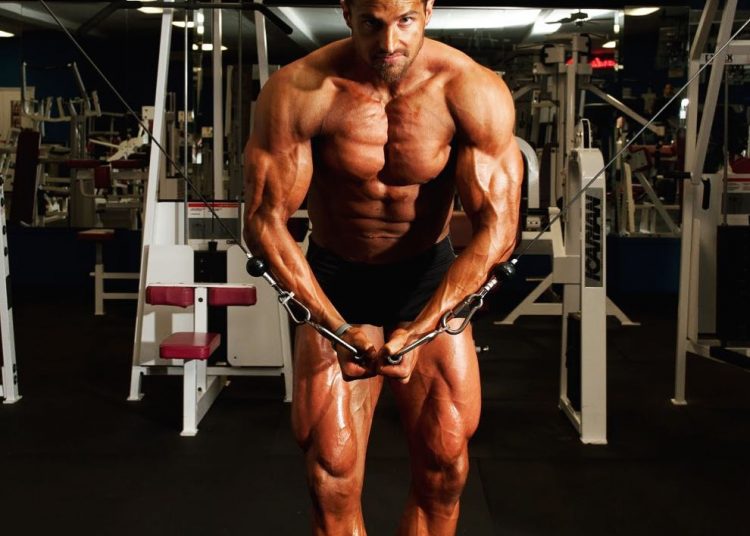While there is nothing to stop you from writing your own bodybuilding training programs, doing so takes time, practice, and skill. You need to understand things like training volume, optimal exercise order, intensity levels, rest periods, and a whole bunch of other important programming details.
Get things right, and you’ll be rewarded with a bespoke program that will produce the precise results you want. But, get things wrong, and you could find yourself going nowhere fast and even backward.
If you don’t have the time to learn how to write your own workouts or are happy to follow the guidance of others, there are plenty of programs to choose from. Just use Google search, Workout Name – FitnessVolt or browse our compressive library of tried and tested workouts.
Or, try this popular workout from bodybuilding guru Layne Norton – the PHAT program. In this article, we discuss what PHAT training is all about, reveal the details of the program, and provide you with a PHAT routine to follow.
Who is Layne Norton?


There are thousands of so-called fitness experts, ranging from people with mountains of qualifications who don’t look like they lift to athletes so genetically blessed (and artificially enhanced) that they look like they know what they’re talking about when, actually, their advice is useless and even dangerous.
Thankfully, the author of PHAT is none of these things!
Instead, Layne Norton is a fitness personality, strength and conditioning coach, natural competitive bodybuilder, and powerlifter who also has a BS in biochemistry and a Ph.D. in nutritional sciences. He’s been in the fitness industry for well over a decade and has been competing for 20 years.
This is a guy who talks the talk AND walks the walk!
In addition to his impressive competitive record, Layne Norton is best known by the training masses for his PHAT program, which combines his love of bodybuilding and powerlifting, and is a type of powerbuilding workout.
PHAT – The Basics
The basic premise of Layne Norton’s PHAT program is simple: muscle strength and mass are directly related. The stronger you are, the heavier you’ll be able to lift, and the more muscle you’ll build. The more muscle you build, the stronger you’ll get. It’s the circle of (bodybuilding) life!
Training for strength and training for muscle size usually involve different workout approaches. Building maximum strength typically means low rep sets and very heavy weights. However, this is not the best way to trigger hypertrophy or muscle growth.
In contrast, most bodybuilding workouts focus more on moderate to light weights and medium to high reps. While this type of training is good for hypertrophy, it’s not as useful for building strength.
Norton’s PHAT program combines both of these approaches to increase muscle strength and size AT THE SAME TIME, which should produce superior training results.
The PHAT training program involves training five days a week, following this split:
The PHAT program is meant to be followed for three months, which is three cycles of four weeks.
Because this is a strength and mass-building workout, if you decide to try PHAT training for yourself, make sure you put yourself into a caloric surplus, pay attention to rest and recovery, and understand that this workout will take a lot out of you.
Where possible, avoid too much additional physical activity outside of your workouts, and eat like it’s your job! After all, this is a bulking program, and if you don’t put back into your body what PHAT training takes out, you won’t get good results.
PHAT Workouts
Layne Norton’s PHAT program is made up of five different workouts. There are two “power” workouts and three hypertrophy workouts. Each muscle group is trained twice per week but using different approaches.
The power workouts include some low rep, heavy weight training not unlike powerlifting. The hypertrophy workouts are more akin to standard bodybuilding training and use lighter weights and higher reps.
There is also some speed work, which involves lifting lighter weights very fast. This increases muscle power and motor unit activation.
Warm-up before you work out
Prepare your body and mind for each workout by warming up before you start. 5-10 minutes of light cardio followed by some dynamic mobility and flexibility work will get the ball rolling.
Finish up your warm-up with a few progressively heavier sets of the main exercises of that day’s program. This will help fire up your muscles and gives you a chance to practice your lifting technique.
Workout 1 – Upper Body Power
 Ronnie Coleman
Ronnie Coleman
For the first part of your PHAT training week, you’re going to be using an upper body/lower body training split. This workout is very back-focused but also works your chest, shoulders, biceps, and triceps.
[*]Pendlay Rows: 3 sets of 3-5 reps
[*]Weighted Pull-Ups: 2 sets of 6-10 reps
[*]Inverted Rows: 2 sets of 6-10 reps
[*]Bench Press: 3 sets of 3-5 reps
[*]Barbell or Dumbbell Overhead Press: 3 sets of 6-10 reps
[*]EZ Bar Curls: 3 sets of 6-10 reps
[*]Skull Crushers: 3 of 6-10 reps
Use a weight that takes you close to failure within the prescribed rep range. For example, if the program calls for 3-5 reps per set, if you are unable to do three reps, the weight is too heavy, but if you can do more than five reps, it’s too light. Try to increase the weight from one week to the next to maintain your progress.
Workout 2 – Lower Body Power


This is arguably the most challenging workout in your PHAT training week. It’s hard and heavy, with lots of volume. Your lower back may also be tired after yesterday’s back-fest!
Take care to warm-up your lower back before you start this workout and focus extra hard on bracing your core to stabilize your lumbar spine. It may be time to break out your weightlifting belt if you haven’t already done so.
[*]Barbell Back Squats: 3 sets of 3-5 reps
[*]Hack Squats: 2 sets of 6-10 reps
[*]Seated Leg Extensions: 2 sets of 6-10 reps
[*]Stiff-Legged Deadlifts: 3 sets of 5-8 reps
[*]Hip Thrust: 2 sets of 6-10 reps
[*]Standing Calf Raises: 3 sets of 6-10 reps
[*]Seated Calf Raises: 2 sets of 6-10 reps
[*]Weighted Crunches: 2 sets of 6-10 reps
Workout 3 – Back and Shoulders Hypertrophy


You’re now finished with the upper body/lower body split, and it’s time to move onto a more traditional bodybuilding three-way body part split. This workout is a nice balance of pushing and pulling exercises. However, it’s a high-volume program, so don’t forget your pre-workout!
[*]Pendlay Rows: 6 sets of 3 reps*
[*]Inverted Rows: 3 sets of 8-12 reps
[*]Seated Cable Row: 3 sets of 8-12 reps
[*]Chest Supported Shrugs: 2 sets of 12-15 reps
[*]Close Grip Pulldowns: 2 sets of 15-20 reps
[*]Seated Dumbbell Presses: 3 sets of 8-12 reps
[*]Uprights Rows: 2 sets of 12-15 reps
[*]Side Lateral Raises: 3 sets of 12-20 reps
[*]Woodchoppers: 3 sets of 8-12 reps
* These are “speed reps” which means you use 65-70% of your 3-5 rep max and do the reps explosively. This will develop muscle power which is, after all, the P in PHAT.
Workout 4 – Lower Body Hypertrophy


It’s time to train your legs again, and this PHAT workout is another lower-body killer. The good news that it’s not all heavy weights and low reps; for a change of pace, you’ll be cranking out some higher reps and chasing the pump.
[*]Barbell Back Squats: 6 sets of 3 reps*
[*]Hack Squats: 3 sets of 8-12 reps
[*]Leg Presses: 2 sets of 12-15 reps
[*]Seated Leg Extensions: 3 sets of 15-20 reps
[*]Stiff-Legged Deadlifts: 3 sets of 8-12 reps
[*]Lying Leg Curls: 2 sets of 12-15 reps
[*]Seated Leg Curls: 2 sets of 15-20 reps
[*]Standing Calf Raises: 4 sets of 10-15 reps
[*]Seated Calf Raises: 3 sets of 15-20 reps
* These are “speed reps,” which means you use 65-70% of your 3-5 rep max and do the reps explosively. This will develop muscle power.
Workout 5 – Chest and Arms Hypertrophy


Somewhat ironically, the Layne Norton PHAT workout ends with what is arguably every bodybuilder’s favorite body parts to train – the chest and arms. At least this means your training week finishes on a high!
[*]Bench Press: 6 sets of 3 reps*
[*]Incline Bench Press: 3 sets of 8-12 reps
[*]Chest Press: 3 sets of 12-15 reps
[*]Incline Cable Flyes: 2 sets of 15-20 reps
[*]Preacher Curls: 3 sets of 8-12 reps
[*]Dumbbell Concentration Curls: 2 sets of 12-15 reps
[*]Spider Curls (incline): 2 sets of 15-20 reps
[*]Seated Triceps Extensions: 3 sets of 8-12 reps
[*]Rope Triceps Push Downs: 2 sets of 12-15 reps
[*]Hydra Presses: 2 sets of 10-12 reps**
* These are “speed reps,” which means you use 65-70% of your 3-5 rep max and do the reps explosively. This will develop muscle power.
PHAT Pros and Cons
There is no such thing as a perfect workout, and that is true for Layne Norton’s PHAT program too. The pros and cons of this training plan include:
Pros
Well-structured workouts – the exercises and workouts follow a logical order, as you’d expect from a knowledgeable coach like Layne Norton.
Straight forward to follow – all the PHAT plan exercises are gym staples that use standard workout equipment. There are no exotic machines or hard-to-learn exercises to worry about. Instead, it focuses on the basics.
A variety of rep ranges – a lot of workouts prescribe three sets of ten of all their exercises. This is lazy programming. PHAT uses several different repetition ranges to keep your workouts interesting and productive.
Build muscle size AND strength – PHAT workouts are a real fitness twofer. Following this workout will make you bigger and stronger. This provides a welcome change from most other bodybuilding programs.
Multi-angled approach – every muscle group is trained with a range of exercises and hits from multiple angles. This is arguably the best way to achieve maximal muscle size while preventing boredom.
Plenty of leg and back work – a lot of training plans focus too much on the mirror muscles on the front of your body. PHAT takes the opposite approach and provides lots of stimulus for your lower body and back, which are arguably more important.


Cons
As good as the PHAT workouts are, there are a few drawbacks too…
No deadlifts – a workout without deadlifts? That’s a training sacrilege! No exercise builds strength and muscle like this powerlifting staple. If you love to deadlift, this might not be the workout for you. Or, you could try and slot it into workout number one or two.
A lot of lower back work – four out of five PHAT workouts involve your lower back, either directly or indirectly. This shouldn’t be a problem if you have a really strong lower back but could be an issue if you suffer from lower back pain.
Some exercises are done twice per week – while rep ranges vary from one workout to the next, with PHAT, you must get used to repeating the same exercises over and over again. This could become boring, especially if you do the full 12-week program.
Long workouts – each PHAT workout lasts between 90 minutes and two hours. That’s a big commitment. If you don’t have a lot of spare time for training, this program could be impractical.
Good recovery is crucial – the PHAT workouts are long and intense; they’re going to take a lot out of you. If you don’t have all recovery ducks in a row, this workout could break you down more than it builds you up. Make sure you take rest and recovery seriously if you try this program.
PHAT Workout Program Spreadsheet
Download the PHAT Workout program from the below link.
Download PHAT Workout Routine in Excel
PHAT FAQs
Got questions about Layne Norton’s PHAT program? We’ll try and answer them!
How long do I rest between sets?
Take 60-90 seconds between sets of 10 reps and above, 90-120 seconds between sets of 6-9 reps, and 2-3 minutes between sets of 3-5 reps. As a rule, the lower the reps, the longer the rests.
Is there a PHAT diet?
There is no official PHAT training diet. However, this is a bulking program, so you’ll need to up your food intake to get good results. We suggest:
Cardio is not part of the PHAT program. That’s because you should be saving your energy for training, rest, recovery, and growth. If you add a lot of cardio to what is already a long and intense training program, you could find yourself suffering from exhaustion.
If you really can’t do without your cardio fix, limit yourself to 20 minutes 2-3 times per week. That will be enough to maintain fitness without using the energy you need for your PHAT workouts.
Can I do different exercises?
While the PHAT workout split is pretty much set in stone, the exercises are a little more flexible. For example, you could replace back squats with front squats or barbell curls with dumbbells curls. In fact, if you do this workout for 12 weeks, some small exercise changes may help prevent boredom.
However, if you do make any changes, make sure you swap “like for like.” By that, we mean use similar exercises. Replacing back squats with front squats is an acceptable adjustment, whereas doing leg extensions instead of squats is not. Stay true to the spirit of the program, and don’t make changes that make the workout easier!
Can I use drop sets and forced reps?
Training systems like drop sets and forced reps will make what is already an intense training program even harder. Try the program for four weeks as it’s written, and then, if you still feel you need them, incorporate the intensifying method(s) of your choice. Be warned, if you do this, you’ll need to pay even more attention to rest and recovery.
Do I need to deload on the PHAT program?
While you don’t have to deload, the occasional reduction in training volume and/or intensity could help stop you from plateauing and prevent over-training. Consider deloading every 4-6 weeks or any time you notice your progress is starting to slow.
Read more about deloading in our in-depth guide.
Layne Norton’s PHAT Workout– Wrapping Up
If you don’t have the time, ability, or interest to write your own workouts, the good news is that there are lots of programs you can follow instead. In most cases, any of these programs are better than going into the gym and making up your workout as you go along.
That said, if you want to build strength and muscle size at the same time, you could do a lot worse than Layne Norton’s PHAT workout program. It’s well-designed, comprehensive, and very accessible as it focuses on basic exercises that you should be able to do in almost any commercial or garage gym.
This is NOT an easy training program, and it’s not really suitable for raw beginners, but if you’ve been lifting consistently for a year and want to take your training to the next level, this could be the workout you want.
Click here to view the article.
Get things right, and you’ll be rewarded with a bespoke program that will produce the precise results you want. But, get things wrong, and you could find yourself going nowhere fast and even backward.
If you don’t have the time to learn how to write your own workouts or are happy to follow the guidance of others, there are plenty of programs to choose from. Just use Google search, Workout Name – FitnessVolt or browse our compressive library of tried and tested workouts.
Or, try this popular workout from bodybuilding guru Layne Norton – the PHAT program. In this article, we discuss what PHAT training is all about, reveal the details of the program, and provide you with a PHAT routine to follow.
Who is Layne Norton?


There are thousands of so-called fitness experts, ranging from people with mountains of qualifications who don’t look like they lift to athletes so genetically blessed (and artificially enhanced) that they look like they know what they’re talking about when, actually, their advice is useless and even dangerous.
Thankfully, the author of PHAT is none of these things!
Instead, Layne Norton is a fitness personality, strength and conditioning coach, natural competitive bodybuilder, and powerlifter who also has a BS in biochemistry and a Ph.D. in nutritional sciences. He’s been in the fitness industry for well over a decade and has been competing for 20 years.
This is a guy who talks the talk AND walks the walk!
In addition to his impressive competitive record, Layne Norton is best known by the training masses for his PHAT program, which combines his love of bodybuilding and powerlifting, and is a type of powerbuilding workout.
PHAT – The Basics
The basic premise of Layne Norton’s PHAT program is simple: muscle strength and mass are directly related. The stronger you are, the heavier you’ll be able to lift, and the more muscle you’ll build. The more muscle you build, the stronger you’ll get. It’s the circle of (bodybuilding) life!
Training for strength and training for muscle size usually involve different workout approaches. Building maximum strength typically means low rep sets and very heavy weights. However, this is not the best way to trigger hypertrophy or muscle growth.
In contrast, most bodybuilding workouts focus more on moderate to light weights and medium to high reps. While this type of training is good for hypertrophy, it’s not as useful for building strength.
Norton’s PHAT program combines both of these approaches to increase muscle strength and size AT THE SAME TIME, which should produce superior training results.
The PHAT training program involves training five days a week, following this split:
- Day 1: Upper Body Power
- Day 2: Lower Body Power
- Day 3: Rest
- Day 4: Back and Shoulders Hypertrophy
- Day 5: Lower Body Hypertrophy
- Day 6: Chest and Arms Hypertrophy
- Day 7: Rest
The PHAT program is meant to be followed for three months, which is three cycles of four weeks.
Because this is a strength and mass-building workout, if you decide to try PHAT training for yourself, make sure you put yourself into a caloric surplus, pay attention to rest and recovery, and understand that this workout will take a lot out of you.
Where possible, avoid too much additional physical activity outside of your workouts, and eat like it’s your job! After all, this is a bulking program, and if you don’t put back into your body what PHAT training takes out, you won’t get good results.
PHAT Workouts
Layne Norton’s PHAT program is made up of five different workouts. There are two “power” workouts and three hypertrophy workouts. Each muscle group is trained twice per week but using different approaches.
The power workouts include some low rep, heavy weight training not unlike powerlifting. The hypertrophy workouts are more akin to standard bodybuilding training and use lighter weights and higher reps.
There is also some speed work, which involves lifting lighter weights very fast. This increases muscle power and motor unit activation.
Warm-up before you work out
Prepare your body and mind for each workout by warming up before you start. 5-10 minutes of light cardio followed by some dynamic mobility and flexibility work will get the ball rolling.
Finish up your warm-up with a few progressively heavier sets of the main exercises of that day’s program. This will help fire up your muscles and gives you a chance to practice your lifting technique.
Workout 1 – Upper Body Power

For the first part of your PHAT training week, you’re going to be using an upper body/lower body training split. This workout is very back-focused but also works your chest, shoulders, biceps, and triceps.
[*]Pendlay Rows: 3 sets of 3-5 reps
[*]Weighted Pull-Ups: 2 sets of 6-10 reps
[*]Inverted Rows: 2 sets of 6-10 reps
[*]Bench Press: 3 sets of 3-5 reps
[*]Barbell or Dumbbell Overhead Press: 3 sets of 6-10 reps
[*]EZ Bar Curls: 3 sets of 6-10 reps
[*]Skull Crushers: 3 of 6-10 reps
Use a weight that takes you close to failure within the prescribed rep range. For example, if the program calls for 3-5 reps per set, if you are unable to do three reps, the weight is too heavy, but if you can do more than five reps, it’s too light. Try to increase the weight from one week to the next to maintain your progress.
Workout 2 – Lower Body Power


This is arguably the most challenging workout in your PHAT training week. It’s hard and heavy, with lots of volume. Your lower back may also be tired after yesterday’s back-fest!
Take care to warm-up your lower back before you start this workout and focus extra hard on bracing your core to stabilize your lumbar spine. It may be time to break out your weightlifting belt if you haven’t already done so.
[*]Barbell Back Squats: 3 sets of 3-5 reps
[*]Hack Squats: 2 sets of 6-10 reps
[*]Seated Leg Extensions: 2 sets of 6-10 reps
[*]Stiff-Legged Deadlifts: 3 sets of 5-8 reps
[*]Hip Thrust: 2 sets of 6-10 reps
[*]Standing Calf Raises: 3 sets of 6-10 reps
[*]Seated Calf Raises: 2 sets of 6-10 reps
[*]Weighted Crunches: 2 sets of 6-10 reps
Workout 3 – Back and Shoulders Hypertrophy


You’re now finished with the upper body/lower body split, and it’s time to move onto a more traditional bodybuilding three-way body part split. This workout is a nice balance of pushing and pulling exercises. However, it’s a high-volume program, so don’t forget your pre-workout!
[*]Pendlay Rows: 6 sets of 3 reps*
[*]Inverted Rows: 3 sets of 8-12 reps
[*]Seated Cable Row: 3 sets of 8-12 reps
[*]Chest Supported Shrugs: 2 sets of 12-15 reps
[*]Close Grip Pulldowns: 2 sets of 15-20 reps
[*]Seated Dumbbell Presses: 3 sets of 8-12 reps
[*]Uprights Rows: 2 sets of 12-15 reps
[*]Side Lateral Raises: 3 sets of 12-20 reps
[*]Woodchoppers: 3 sets of 8-12 reps
* These are “speed reps” which means you use 65-70% of your 3-5 rep max and do the reps explosively. This will develop muscle power which is, after all, the P in PHAT.
Workout 4 – Lower Body Hypertrophy


It’s time to train your legs again, and this PHAT workout is another lower-body killer. The good news that it’s not all heavy weights and low reps; for a change of pace, you’ll be cranking out some higher reps and chasing the pump.
[*]Barbell Back Squats: 6 sets of 3 reps*
[*]Hack Squats: 3 sets of 8-12 reps
[*]Leg Presses: 2 sets of 12-15 reps
[*]Seated Leg Extensions: 3 sets of 15-20 reps
[*]Stiff-Legged Deadlifts: 3 sets of 8-12 reps
[*]Lying Leg Curls: 2 sets of 12-15 reps
[*]Seated Leg Curls: 2 sets of 15-20 reps
[*]Standing Calf Raises: 4 sets of 10-15 reps
[*]Seated Calf Raises: 3 sets of 15-20 reps
* These are “speed reps,” which means you use 65-70% of your 3-5 rep max and do the reps explosively. This will develop muscle power.
Workout 5 – Chest and Arms Hypertrophy


Somewhat ironically, the Layne Norton PHAT workout ends with what is arguably every bodybuilder’s favorite body parts to train – the chest and arms. At least this means your training week finishes on a high!
[*]Bench Press: 6 sets of 3 reps*
[*]Incline Bench Press: 3 sets of 8-12 reps
[*]Chest Press: 3 sets of 12-15 reps
[*]Incline Cable Flyes: 2 sets of 15-20 reps
[*]Preacher Curls: 3 sets of 8-12 reps
[*]Dumbbell Concentration Curls: 2 sets of 12-15 reps
[*]Spider Curls (incline): 2 sets of 15-20 reps
[*]Seated Triceps Extensions: 3 sets of 8-12 reps
[*]Rope Triceps Push Downs: 2 sets of 12-15 reps
[*]Hydra Presses: 2 sets of 10-12 reps**
* These are “speed reps,” which means you use 65-70% of your 3-5 rep max and do the reps explosively. This will develop muscle power.
PHAT Pros and Cons
There is no such thing as a perfect workout, and that is true for Layne Norton’s PHAT program too. The pros and cons of this training plan include:
Pros
Well-structured workouts – the exercises and workouts follow a logical order, as you’d expect from a knowledgeable coach like Layne Norton.
Straight forward to follow – all the PHAT plan exercises are gym staples that use standard workout equipment. There are no exotic machines or hard-to-learn exercises to worry about. Instead, it focuses on the basics.
A variety of rep ranges – a lot of workouts prescribe three sets of ten of all their exercises. This is lazy programming. PHAT uses several different repetition ranges to keep your workouts interesting and productive.
Build muscle size AND strength – PHAT workouts are a real fitness twofer. Following this workout will make you bigger and stronger. This provides a welcome change from most other bodybuilding programs.
Multi-angled approach – every muscle group is trained with a range of exercises and hits from multiple angles. This is arguably the best way to achieve maximal muscle size while preventing boredom.
Plenty of leg and back work – a lot of training plans focus too much on the mirror muscles on the front of your body. PHAT takes the opposite approach and provides lots of stimulus for your lower body and back, which are arguably more important.


Cons
As good as the PHAT workouts are, there are a few drawbacks too…
No deadlifts – a workout without deadlifts? That’s a training sacrilege! No exercise builds strength and muscle like this powerlifting staple. If you love to deadlift, this might not be the workout for you. Or, you could try and slot it into workout number one or two.
A lot of lower back work – four out of five PHAT workouts involve your lower back, either directly or indirectly. This shouldn’t be a problem if you have a really strong lower back but could be an issue if you suffer from lower back pain.
Some exercises are done twice per week – while rep ranges vary from one workout to the next, with PHAT, you must get used to repeating the same exercises over and over again. This could become boring, especially if you do the full 12-week program.
Long workouts – each PHAT workout lasts between 90 minutes and two hours. That’s a big commitment. If you don’t have a lot of spare time for training, this program could be impractical.
Good recovery is crucial – the PHAT workouts are long and intense; they’re going to take a lot out of you. If you don’t have all recovery ducks in a row, this workout could break you down more than it builds you up. Make sure you take rest and recovery seriously if you try this program.
PHAT Workout Program Spreadsheet
Download the PHAT Workout program from the below link.
Download PHAT Workout Routine in Excel
PHAT FAQs
Got questions about Layne Norton’s PHAT program? We’ll try and answer them!
How long do I rest between sets?
Take 60-90 seconds between sets of 10 reps and above, 90-120 seconds between sets of 6-9 reps, and 2-3 minutes between sets of 3-5 reps. As a rule, the lower the reps, the longer the rests.
Is there a PHAT diet?
There is no official PHAT training diet. However, this is a bulking program, so you’ll need to up your food intake to get good results. We suggest:
- Consume 0.8 to 1.2 grams of quality protein per pound of body weight
- Consume 20-30% of total calories from healthy fats
- Fill the rest of your calories with carbohydrates
- Consume a caloric surplus of 500 calories above maintenance each day
- Use mass supplements, including creatine, whey protein, pre-workouts, and BCAAs
Cardio is not part of the PHAT program. That’s because you should be saving your energy for training, rest, recovery, and growth. If you add a lot of cardio to what is already a long and intense training program, you could find yourself suffering from exhaustion.
If you really can’t do without your cardio fix, limit yourself to 20 minutes 2-3 times per week. That will be enough to maintain fitness without using the energy you need for your PHAT workouts.
Can I do different exercises?
While the PHAT workout split is pretty much set in stone, the exercises are a little more flexible. For example, you could replace back squats with front squats or barbell curls with dumbbells curls. In fact, if you do this workout for 12 weeks, some small exercise changes may help prevent boredom.
However, if you do make any changes, make sure you swap “like for like.” By that, we mean use similar exercises. Replacing back squats with front squats is an acceptable adjustment, whereas doing leg extensions instead of squats is not. Stay true to the spirit of the program, and don’t make changes that make the workout easier!
Can I use drop sets and forced reps?
Training systems like drop sets and forced reps will make what is already an intense training program even harder. Try the program for four weeks as it’s written, and then, if you still feel you need them, incorporate the intensifying method(s) of your choice. Be warned, if you do this, you’ll need to pay even more attention to rest and recovery.
Do I need to deload on the PHAT program?
While you don’t have to deload, the occasional reduction in training volume and/or intensity could help stop you from plateauing and prevent over-training. Consider deloading every 4-6 weeks or any time you notice your progress is starting to slow.
Read more about deloading in our in-depth guide.
Layne Norton’s PHAT Workout– Wrapping Up
If you don’t have the time, ability, or interest to write your own workouts, the good news is that there are lots of programs you can follow instead. In most cases, any of these programs are better than going into the gym and making up your workout as you go along.
That said, if you want to build strength and muscle size at the same time, you could do a lot worse than Layne Norton’s PHAT workout program. It’s well-designed, comprehensive, and very accessible as it focuses on basic exercises that you should be able to do in almost any commercial or garage gym.
This is NOT an easy training program, and it’s not really suitable for raw beginners, but if you’ve been lifting consistently for a year and want to take your training to the next level, this could be the workout you want.
Click here to view the article.

